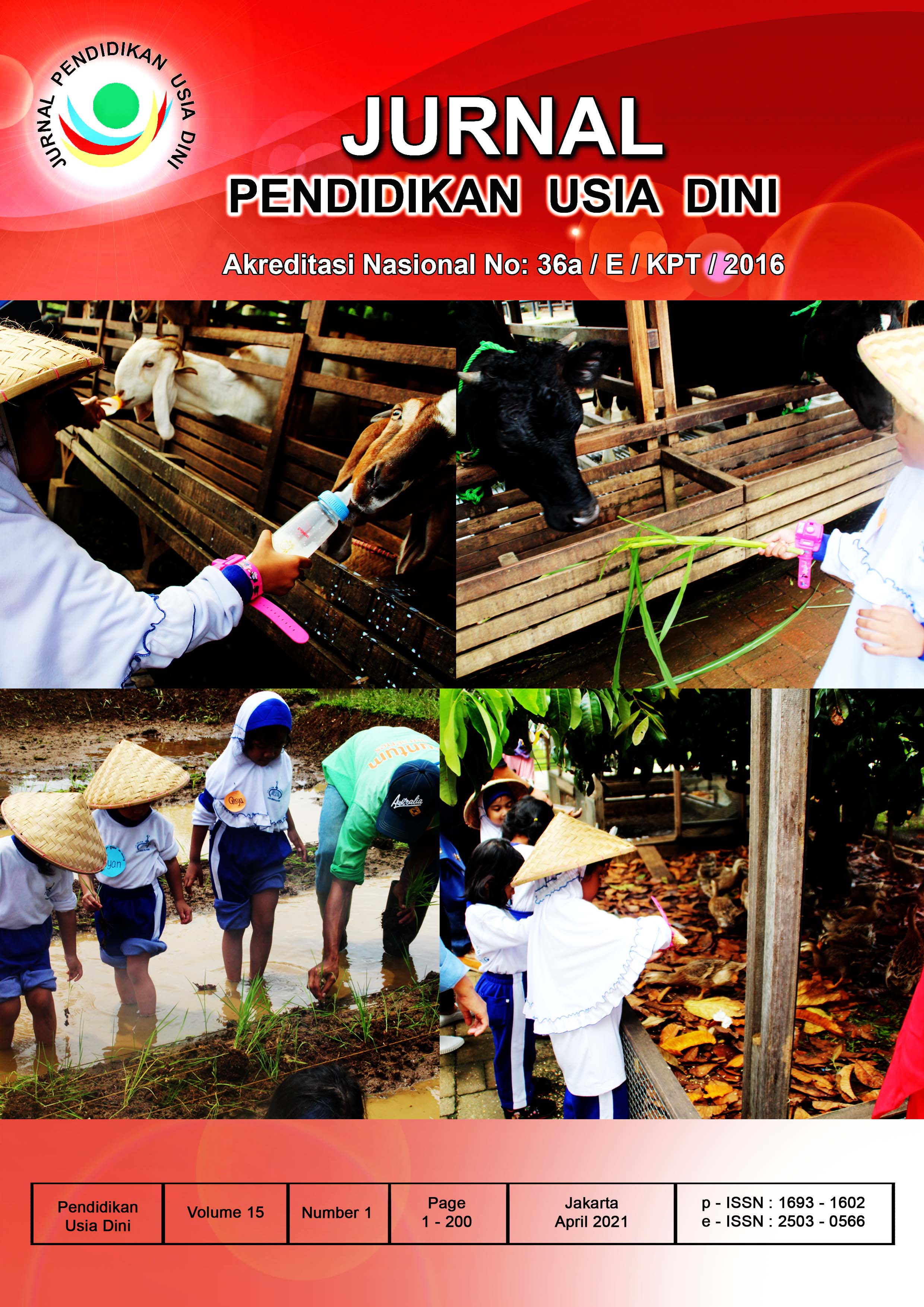Early Childhood Education: Contextual Thematic Teaching Materials Based on Classroom Activities
DOI:
https://doi.org/10.21009/JPUD.151.10Abstract
Contextual learning binds the content of the subjects in the classroom with the context of the children's daily lives. Learning in early childhood classes (0-8 years) is carried out using the thematic method, which combines several learning materials into one subject. Thematic teaching resources in early childhood classes are still limited in number and rely on textbooks provided by the government. This study aims to develop activity-based teaching materials to assess contextual thematic learning. This research method uses model development research by Borg and Gall with data collection techniques using panels and questionnaires on expert tests, one to one test, small-group test, and large-group test. The research data analysis technique used mixed methods, namely quantitative data tabulated in the form of percentages and described in the qualitative form. The expert test provides recommendations that the instrument can be used to assess student teaching materials and teacher guidance. Teaching materials and teacher guides are suitable for use, and further testing is carried out. Based on the results of the one-to-one test, small-group test, and large-group test, both teaching materials and teacher guides are readability and eligibility with an average of 85.00. The implication of this research, it is suggested that early childhood education institutions where the pilot can use teaching materials and teacher guides in developing and assessing activity-based contextual thematic learning for further research.
Keywords: Early Childhood Education, Contextual Thematic, Classroom Activities
References:
Aini, Q., & Relmasira, S. C. (2018). Penerapan Pembelajaran Tematik Integratif Berbasis Kontekstual untuk Meningkatkan Keaktifan dan Hasil Belajar Siswa Kelas 1 SD. Sekolah Dasar: Kajian Teori Dan Praktik Pendidikan, 27(2), 124–132. https://doi.org/10.17977/um009v27i22018p124
Anggo, M., Kadir, Lambertus, Jazuli, L. O., Suhar, & Kansil, Y. E. (2015). Metacognitive strategies on mathematics learning to improve student’s environmental awareness. International Journal of Education and Research, 3(4), 133–142.
Borg, W. R., & Gall, M. D. (2007). Educational Research An Introduction. Fourth Edition. Bacon Publishing.
Crain, S., & Thornton, R. (2012). Syntax acquisition. Wiley Interdisciplinary Reviews: Cognitive Science, 3(2), 185–203. https://doi.org/10.1002/wcs.1158
Daryanto. (2011). Media Pembelajaran. Satu Nusa.
Davidova, J. (2020). Thematic Approach as The Basis of Integrative Music Teaching/Learning in Preschool. 4177–4185. https://doi.org/10.21125/iceri.2020.0934
Fadillah, A., Dewi, N. P. L. C., Ridho, D., Majid, A. N., & Prastiwi, M. N. B. P. (2017). The Effect of Application of Contextual Teaching and Learning (CTL) Model-Based on Lesson Study with Mind Mapping Media to Assess Student Learning Outcomes on Chemistry on Colloid Systems. International Journal of Science and Applied Science, 1(2), 101–108.
Fogarty, R. (1991). Ten Ways to Integrate Curriculum. Educational Leadership, 49(2), 61–65.
Johnson, E. B. (2007). Contextual Teaching & Learning (I. Setiawan, Ed.). MLC.
Krasovska, O., Miskova, N., & Veremchuk, A. (2020). Professional Training of Future Preschool Teachers in the Field of Artistic and Aesthetic Education by Means of Contextual Learning Technologies. Behavioral Sciences, 10(2), 50. https://doi.org/10.3390/bs10020050
- Atwi Suparman. (2007). Desain Instruksional Modern: Panduan Para Pengajar dan Inovator Pendidikan. Erlangga.
Majid, A. (2014). Pembelajaran Tematik Terpadu. Remaja Rosda Karya.
Miles, M. B., Huberman, A. M., & Saldaña, J. (2014). Qualitative data analysis: A methods sourcebook (Third edition). SAGE Publications, Inc.
Mudlofir, A. (2011). Aplikasi Pengembangan Kurikulum Tingkat Satuan Pendidikan dan Bahan Ajar dalam Pendidikan Agama Islam. Raja Grafindo Persada.
Ormrod, J. E. (2008). Psikologi Pendidikan Membantu Siswa Tumbuh dan Berkembang, Erlangga, 2008 (6th ed.). Erlangga.
Prastowo, A. (2011). Panduan kreatif membuat bahan ajar inovatif. Diva Press.
Puskur. (2018). Monitoring dan Evaluasi Pelaksanaan Pembelajaran Tematik.
Puspita, A. M. I. (2018). The Effect of Contextual-Based Thematic Teaching Materials towards Student Learning Activity. Jurnal Inovasi Pendidikan Dasar, 3(2), 47–52.
Sadjati, I. M. (2017). Hakikat Bahan Ajar (Vol. 3, Issue 1). Universitas Terbuka. https://doi.org/10.1017/CBO9781107415324.004
Semiawan, C. R. (2008). Belajar dan Pembelajaran Prasekolah dan Sekolah Dasar. Indeks.
Slavin, RobertE. (2018). Educational psychology. In Psychological Bulletin (12th ed.). Pearson. https://doi.org/10.1037/h0075790
Soedijarto, Thamrin, Karyadi, B., Siskandar, & Sumiyati. (2010). Sejarah Pusat Kurikulum.
Sukmawati, F. (2015). Pengembangan Bahan Ajar Biologi Berbasis Contextual Teaching Learning untuk Mengefektifkan Pembelajaran Bagi Siswa SMA. FENOMENA, 7(1), 145–154.
Susialita, T. (2016). The Development of Audio-Visual Students Portofolio (LKS) Contextual Teaching and Learning-Based (CTL) on Sound Chapter of Science Subject for Deaf Students. Jurnal Pendidikan IPA Indonesia, 5(2), 192–198.
Trianto. (2011). Desain Pengembangan Pembelajaran Tematik Bagi Anak Usia Dini TK/RA & Anak kelas awal SD/MI. Kencana Prenada Media Group.
Ukala, C. C. (2012). Resource capacity for the implementation of early childhood Education in Public and private school in Rivers State. University of Port Harcourt.
Downloads
Published
How to Cite
Issue
Section
License
JURNAL PENDIDIKAN USIA DINI work is licensed under a Creative Commons Attribution 4.0 International License. (http://creativecommons.org/licenses/by/4.0/)





